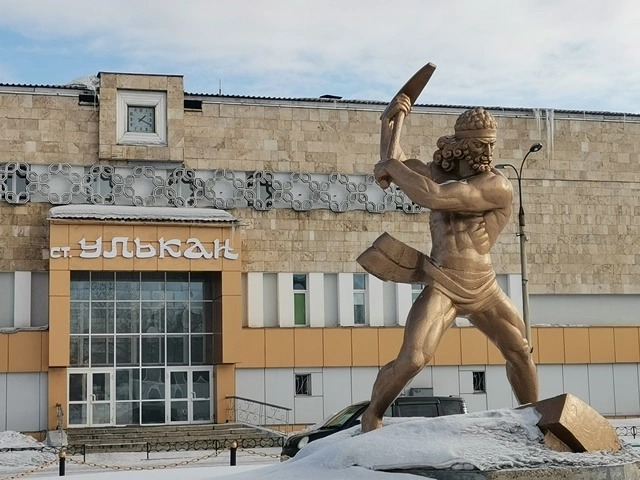
Azerbaijani President Ilham Aliyev was in Moscow on 22 April 22, where he met with Vladimir Putin to celebrate the anniversary of the BAM Railway, the construction of which involved many Azerbaijanis, not least the president’s father, Heydar Aliyev.
Image: president.az
The Baikal-Amur Mainline (or ‘BAM’) crosses over 3400km of remote Siberian wilderness. It’s one of the world’s longest railways. And one of the most expensive ever built. Yet few have ever heard of it, let alone ridden its rails. A guidebook for travellers on the line published in 1996 was dubbed by the UK press the “most esoteric travel guide” written that year.

Image: Wikipedia
The BAM creates a second line running approximately parallel to the main TransSiberian route in eastern Russia. A western parallel section had existed since 1930 when the original TransSiberian mainline, via Samara and Ufa, was doubled by the newer route west of Omsk. The BAM idea was first mooted in 1908, and some short sections were laid in the 1950s (using Gulag prison labour), but the Stalin era plan was mothballed. However, in the 1970s, it became clearer than ever that having a parallel further east would be of great strategic importance for the USSR in ensuring an alternative link to ports in the Russian Far East.
The second aim of opening up land for potential development was more optimistic. After all, the line runs mostly through uninhabited wilderness with difficult topography that necessitated 400km of bridges and 47km of tunnels. Also, much of the ground is permafrost in the regions that the BAM crosses. That makes building infrastructure very difficult as the earth is frozen solid—and the pressure of construction can lead to partial melting that undermines foundations. Constructing the BAM was a remarkable achievement in itself, requiring special technology to deal with laying the line across permafrost, and climate change is a threat as if the land thaws too much, the earth beneath the sleepers can turn to mush, destabilizing the railway’s mechanical integrity.
Nonetheless, the BAM remains in service and indeed the line’s importance for freight was underlined by plans to increase capacity by 2025 to cope with anticipated growth in coal exports to the Asian market from the port of Vanino at the northern end of the Sea of Japan.
In the 1970s, when BAM construction started in earnest, the project was seen as more than just a feat of engineering. When the ‘golden link’ was connected at Balbukhta at 10 am on 29 September 1984, signalling the completion of the BAM’s main section, the event evoked enormous pride in the USSR, representing a feat almost equal to the launch of Yuri Gagarin as the world’s first spaceman. The BAM workers—known as bamovtsy—were seen as heroes fighting extreme adversity, encapsulated by the slogan “We built the BAM, and the BAM built us.” Seen in some ways as representing a microcosm of the Soviet Union, teams of bamovtsy from different republics and ethnicities focussed on one particular section of the line and often stayed on to populate the new settlement around their key station—thanked for their years of deprivation and hard labour by a supply of provisions and minor luxuries that were above and beyond what most Soviet workers could expect in less remote locations.

Ulkan Station on the BAM railway—designed and built by Azerbaijanis in the 1970s. Image: roadtripsacrossrussia.com
Azerbaijanis constructed the station and township at Ulkan, 209km east of Tayshet (where the BAM branches off the TransSiberian mainline). Azerbaijanis settled here, and their descendants still remain in some number, according to recent reports.
Later (around 1983), Azerbaijanis of the AzBamStroy unit also created Angoyanskoe Village 120km east of Severobaikalsk, where Angoya station was renamed in honour of Heydar Aliyev in 2008.

Heydar Aliyev plaque at Angoya station. Image: a-krotov.livejournal.com
While that might be seen as some sort of diplomatic tokenism, in fact Heydar Aliyev was inded a crucial force behind the whole BAM project. He was among those to welcome the first BAM construction brigade in early 1975, and in June 1984, the summer before the ‘golden link’ connection was made, he spent over a week making a tour of inspection to get a proper sense of the line’s state of readiness.

Image: azernews.az
By this stage, Aliyev was not only a Politburo member but also the chairman of the State Commission for the Construction of the BAM, so the project was of great personal importance. Last year, an exhibition in Irkutsk commemorating Aliyev’s centenary, outlined some of the ways in which he had contributed to BAM.
At this week’s meeting between Ilham Aliyev and Putin, the great labour and sacrifice of the bamovtsy were hailed, but Heydar Aliyev’s role was further underlined[1]—symbolizing the continuing close relationship between Russia and Azerbaijan. Still, as one Russian blogger mused, it’s ironic that Aliyev should now be commemorated while Leonid Brezhnev, the Russian leader of the USSR at the time of the railway’s construction, should have no memorial on any of the BAM line stations.
[1] Tass reports that Azerbaijani workers are once again part of the renovation and upgrading of a section of the BAM line—this time further east in the Khabarovsk region.
Share on social media